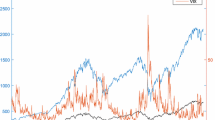Abstract
The selection of an appropriate portfolio hedging strategy is a concern for both investment theory and practice. Options are believed to be flexible and useful hedging instruments, but they are also complicated to manage and costly to implement in a strategy, intensifying the financial leverage, and thus increasing the riskiness of a portfolio. This paper investigates the hedging strategies with options as efficient hedging tools and the possibility to identify an efficient hedging strategy with options that will not result in smaller utility for investors, compared to other strategies under defined criteria. The empirical analysis is based on simulated returns of the following trading strategies: a covered call, protective put, collar, ratio covered call strategy and a buy-and-hold unhedged stock. The return distributions of these strategies are compared using the stochastic dominance criteria up to the third degree, which is an appropriate approach for investors who prefer the greater return, are risk-averse in terms of downside volatility and in terms of a loss, and who prefer greater positive skewness. The results obtained from the simulated returns indicate that portfolio hedging strategies with options are never dominated by an unhedged portfolio. This finding confirms that hedging strategies with options are useful tools for risk hedging. The methodology used in the paper also presents the general framework that can be used in investment decision-making in the presence of uncertainty.

Similar content being viewed by others
Notes
Although Davidson and Duclos (2013) emphasize that bootstrap method increases the strength of the test, their simulations show that the difference between different approaches is negligible if the samples are larger than 500 observations. Since this condition is met in our study, we found no reason to use a computer-intensive bootstrap approach.
t-statistics are available upon request.
References
Abid F, Mroua M, Wong W-K (2014) International diversification versus domestic diversification: mean-variance portfolio optimization and stochastic dominance approaches. J Risk Financ Manag 2:45–66
Aven T (2016) Risk assessment and risk management: review of recent advances on their foundation. Eur J Oper Res 253(1):1–13
Bishop J, Formby J, Thistle PD (1992) Convergence of the South and Non-South Income Distributions, 1969–1979. Am Econ Rev 82:262–272
Black F, Scholes M (1973) Pricing of options and corporate liabilities. J Polit Econ 81(3):637–654
Bollen NPB (1999) Measuring the benefits of option strategies for portfolio management. Catalyst Institute Report. http://www.owen.vanderbilt.edu/nick.bollen/themes/asx1.pdf. Accessed 18 Sept 2018
Boostaber R, Clarke R (1984) Option portfolio strategies: measurement and evaluation. J Bus 57(4):469–492
Booth JR, Tehranian A, Trennepohl GL (1985) Efficiency analysis and option portfolio selection. J Financ Quant Anal 4:435–450
Brooks R, Levy H, Yoder J (1987) Using stochastic dominance to evaluate the performance of portfolios with options. Financial Analysts Journal, March/April, pp 79–82
Castellano R, Giacometti R (2001) Performance of a hedged stochastic portfolio model in the presence of extreme events. Comput Econ 17:239–252
Clarke RG (1987) Stochastic dominance properties of option strategies. In: Fabozzi FJ (ed) Advances in futures and options research, 2. JAI Press, London
Dash M, Goel A (2014) A comparison of ITM and OTM protective-puts and covered-calls. Asian J Finance Account 6(1):126–137
Davidson R, Duclos JY (2006) Testing for restricted stochastic dominance. CIRPÉE working paper 06–09
Davidson R, Duclos JY (2013) Testing for restricted stochastic dominance. Econom Rev 32(1):84–125
Faias JA, Santa-Clara P (2017) Optimal option portfolio strategies. J Financ Quant Anal 52(1):277–303
Friedman M, Savage LJ (1948) The utility analysis of choices involving risk. J Polit Econ 56(4):279–304
Hemler ML, Miller TW (2015) The performance of options-based investment strategies: evidence for individual stocks during 2003–2013. Mendoza College of Business, University of Notre Dame. https://www.optionseducation.org/referencelibrary/research-articles/page-assets/perf-options-strategies.aspx. Accessed 30 Sept 2018
Hodder JE, Jackwerth JC, Kolokolova O (2013) Improved portfolio choice using second-order stochastic dominance. University of Konstanz, Department of Economics working paper series 2010–2014
Isakov D, Morard B (2001) Improving portfolio performance with option strategies: evidence from Switzerland. Eur Financ Manag 7(1):73–91. https://doi.org/10.1111/1468-036X.00145
Koopmans TC (ed) (1951) Activity analysis of production and allocation. Wiley, New York
Levy H (2006) Stochastic dominance: investment decision making under uncertainty, 2nd edn. Springer, New York
Levy H (2016) Stochastic dominance: Investment Decision Making under Uncertainty, 3rd edn. Springer, New York
Lhabitant F-S (2000) Derivatives in portfolio management: Why beating the market is easy. EDHEC risk and asset management research centre working paper.http://www.edhec-risk.com/edhec_publications/RISKReview1055927251987929638/attachments/EDHEC_WhyBeatingTheMarketIsEasy.pdf. Accessed 30 Sept 2018
Merton RC, Scholes M, Gladstein ML (1978) The returns and risks of alternative call option portfolio investment strategies. J Bus 51:183–242
Miller MB (2012) Mathematics and statistics for financial risk management. Wiley, Hoboken
Mitra S (2017) Efficient option risk measurement with reduced model risk. Insurance: Math Econ 72:163–174. https://doi.org/10.1016/j.insmatheco.2016.09.006
Scott RC, Horvath PA (1980) On the direction of preference for moments of higher order than the variance. J Finance 35(4):915–919
Szado E, Schneeweis T (2012) Option-based risk management in a multi-asset World. Options Education documents. https://www.optionseducation.org/referencelibrary/research-articles/page-assets/options-based-risk-mgmt.aspx. Accessed 1 Sept 2017
Tapiero CS (2004) Risk and financial management. Wiley, Gulford
Trennepohl G, Dukes W (1981) An empirical test of option writing and buying strategies utilizing in-the-money and out-of-the-money contracts. J Bus Finance Account 8(2):185–202
Ury HK, Stoline MR, Mitchell BT (1979) Tables of the studentized maximum modulus distribution and an application to multiple comparisons among means. Technometrics 21(1):87–93
Ury HK, Stoline MR, Mitchell BT (1980) Further tables of the studentized maximum modulus distribution. Commun Stat Simul Comput 9(2):167–178
Wong W-K, Phoon KF, Lean HH (2008) Stochastic dominance analysis of Asian hedge funds. Pac-Basin Finance J 16(3):204–223
Acknowledgements
Thanks to the OBEX project and Mrs Mohini Ganguly for language editing of this manuscript.
Author information
Authors and Affiliations
Corresponding author
Additional information
Publisher's Note
Springer Nature remains neutral with regard to jurisdictional claims in published maps and institutional affiliations.
Appendix
Appendix
Rights and permissions
About this article
Cite this article
Kedžo, M.G., Šego, B. The relative efficiency of option hedging strategies using the third-order stochastic dominance. Comput Manag Sci 18, 477–504 (2021). https://doi.org/10.1007/s10287-021-00401-z
Received:
Accepted:
Published:
Issue Date:
DOI: https://doi.org/10.1007/s10287-021-00401-z



